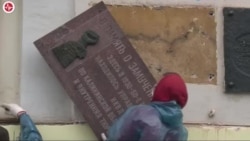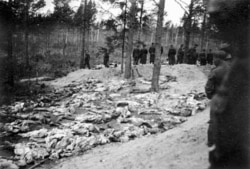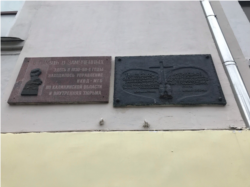On April 7, a group of local activists from the pro-Kremlin National Liberation Movement (NOD) in the city of Tver near Moscow removed two plaques commemorating the 1940 mass execution of Polish POWs from the walls of the Tver Medical University, where the regional branch of the NKVD, the Soviet secret police, was headquartered during WWII.
The mass executions were part of what became known as the Katyn massacre, named after the village where most of the 22,000 Polish military officers and intellectuals were killed in April-May 1940.
NOD representative Maxim Kormushkin, who took part in the plaques’ removal wearing a Soviet army-style outfit, told the local Tver News agency that this was “a historic moment.”
“The thing is, while this plaque was placed on the Medical Academy building illegally, without any historical grounds, it … is a historic relic of a sorts because of how many spears were broken by the opponents and supporters of that version. So today common sense finally prevailed, which is supported by historic documents that there were no such executions and so on,” Kormushkin told Tver News in a video posted on its YouTube channel.
The claim is false.
The Soviet Union invaded Poland in September 1939 and occupied the eastern part of the country at the same time Nazi Germany invaded and occupied western Poland. Under the terms of the Molotov-Ribbentrop pact, the occupying powers divided the country into two separate spheres of control and began eliminating Poland’s military and intellectual elite, as well as its Jewish population.
The Soviet NKVD, the predecessor of the KGB and FSB, placed thousands of Poles in concentration camps, including in the Russian town of Kozielsk near the city of Smolensk.
Germany seized Smolensk from the Soviet Union in the summer of 1941.
On April 13, 1943, German occupying forces announced the discovery of eight mass graves in a forest on the outskirts of the village of Katyn near Smolensk. The graves contained the remains of thousands of the Polish Army officers and intellectual leaders who had been interned in the Kozielsk prisoner-of-war camp. The Nazi regime blamed Soviet forces for the mass executions.
According to records stored in the U.S. National Archives, Germany invited an international commission of medical experts, who excavated the graves in the spring of 1943 and concluded that the massacre occurred in 1940, when the area was under Soviet control.
A few months later, in the fall of 1943, Soviet forces recaptured Smolensk, after which they conducted their own excavation and announced that the massacre occurred in 1941, when the region was under Nazi occupation. Soviet authorities subsequently blamed German forces for the killings.
For nearly five decades, until just before its own demise, the Soviet Union continued to deny responsibility for the Katyn massacre.
On April 13, 1990, the Soviet government released a statement to the state-owned news agency TASS accepting responsibility for the execution of 22,000 Poles, calling the massacre “one of the most heinous crimes of Stalinism.”
On April 28, 2010, Russia’s then-President Dmitry Medvedev ordered the release of the “original Katyn documents,” including the lists of the executed and the execution orders.
While the page where these NKVD archives were located still exists on the Russian government archives website, the documents themselves, which were designated “Documents on the ‘problem of Katyn’ from ‘package 1’,” are no longer accessible.
The two plaques in Tver commemorating the Katyn massacre -- one in Russian, the other in Polish -- were placed on the façade of the city’s Medical University in 1991 and 1992 on the orders of the Tver city council. Until 1954, the building had housed the regional headquarters of the Soviet secret police. According to archival documents, more than 6,000 poles were tortured and killed in the building’s basement.
In December 2019, the Tver prosecutor’s office ordered that the Katyn plaques be removed from the Medical University building’s façade, claiming that the annual commemoration ceremonies posed “a security threat to the students and the faculty.” While insisting the order had “no political background whatsoever,” the prosecutor’s decree also stated that “the writings on the memorial plaques are not based on documented facts.”
Russia’s return to the Soviet World War II historical narrative has been increasingly visible in the country’s foreign policy, as well as in daily life at home. Experts say the rewriting of history and return to propaganda about the Soviet Union’s great patriotic victory, including the glamorization of Stalin, has become key to Vladimir Putin’s popularity.








